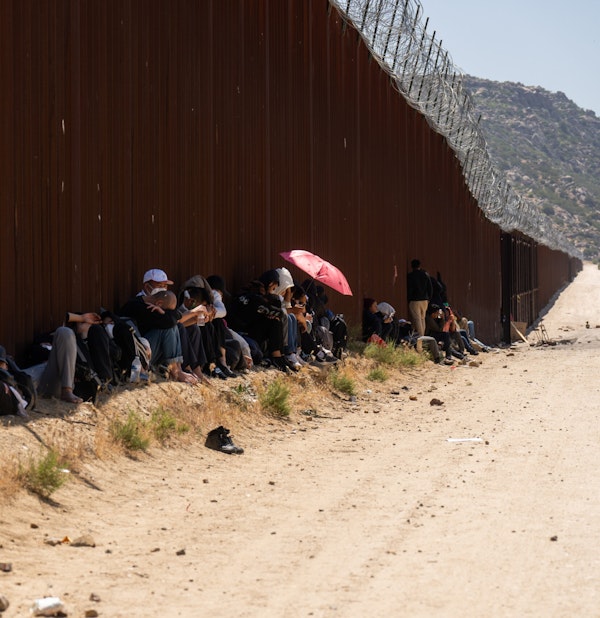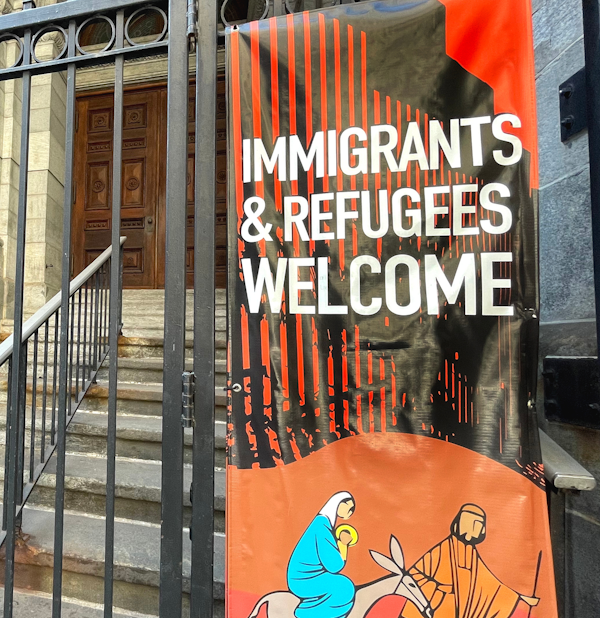Interview
Building a better immigration system
Laura Collins on how a smart new approach could help drive the U.S. economy
 President and Mrs. Bush at a naturalization ceremony at the George W. Bush Presidential Center on March 18, 2019. (Photo by Grant Miller for the George W. Bush Presidential Center)
President and Mrs. Bush at a naturalization ceremony at the George W. Bush Presidential Center on March 18, 2019. (Photo by Grant Miller for the George W. Bush Presidential Center)
In the last few years, more people have been violently displaced from their homes than ever before, and both voluntary and forced migration have hit record levels around the world. Inside the United States, the public debate has focused mostly on unlawful immigration and whether and how to remove people who entered the country illegally. Too little attention has been given to our legal immigration system – even though the U.S. economy is booming and employers can’t find the workers they need. To discuss all this and more, The Catalyst’s Jonathan Tepperman spoke with Laura Collins, a Director at the Bush Institute-SMU Economic Growth Initiative. Their conversation, which has been edited for length and clarity, drew on the Bush Institute’s new policy brief on immigration, which you can find here.
I want to start with what will sound like an obvious question, because I think it bears repeating. How does the United States benefit from legal immigration?
We at the Bush Institute believe that immigrants are important for America’s prosperity, vitality, and security. They fill open jobs and increase productivity by making sure we have the labor force that we need. They’re entrepreneurial – they start businesses at a greater rate than native-born Americans. A lot of talent comes into our country from abroad. Immigrants tend to be holders of patents. They start new companies that do a lot for our technology sector. Their labor-force participation rate is very high. And they pay into our entitlement systems through their taxes, even though most immigrants don’t qualify to receive benefits for at least five years.
Immigrants also keep the U.S. population younger. Most legal immigrants are prime working age, whereas a lot of America is graying. That’s important for our economy and our security.
You’ve argued that the exclusive political focus on enforcement and removals is a mistake. Explain why that’s so.
It’s a mistake because it neglects half of the conversation. Immigration reform is not just about the border, and it’s not just about the undocumented. It is about building a system that is going to benefit America in the long run.
Right now, we have a system that hasn’t been substantially overhauled since the mid-1960s. We took a few bites at the apple in the 1980s and 1990s and made a few changes, but generally speaking, we’re still trying to operate a 21st century economy on an immigration system that was built many many years ago.
Describe the key flaws in the current system.
Because we bring in so many people through family-based sponsorship, we’re often not bringing in people who have the knowledge and skills that match our open jobs. If we were to flip the system and bring in more people based on their employment history, based on their skills, and based on their education, we would be able to fill the jobs we have more easily.
That’s not to say that the family-based system is all bad. It’s not. We know that lots of family-based migrants do perform jobs the economy needs. But we’re not matching them to open jobs in the most efficient way.
So what would a good alternative look like?
There are a few different alternatives. We could flip to a system based on employer sponsorship. We already have a system set up for that, but we would have to increase the number of green cards available for employer sponsorship. Or we could consider imitating countries that have point systems that allow potential immigrants to self sponsor. You can apply to come in and say, “I’m a skilled worker and I have an education, I have things that I can contribute,” and if they’re the skills and education that country needs, you get it. Canada’s system works in that way. We could consider that here. But making that kind of reform would take a much bigger leap in the United States, which currently offers very few self-sponsorship opportunities.
Another approach is to augment our workforce with a temporary worker system. The United States already has such a system that works very well, but it doesn’t offer enough worker visas to fill all the open jobs.
None of these systems are necessarily better than the others; Congress should decide which will best set up our workforce to thrive in the future.
 Migrants sit by the iron fence waiting to be processed by the U.S. Border Patrol near the Jacumba Hot Springs after crossing the U.S.-Mexico border on June 13, 2024. (Photo by Qian Weizhong/VCG via Getty Images)
Migrants sit by the iron fence waiting to be processed by the U.S. Border Patrol near the Jacumba Hot Springs after crossing the U.S.-Mexico border on June 13, 2024. (Photo by Qian Weizhong/VCG via Getty Images)
Is this a number problem? That is, are we admitting too few people total, and too slowly?
The United States admits too few immigrants per year to keep up with the number of jobs available, and that’s true even in years where we’ve admitted the maximum number of people that we can. Our immigration system really needs to grow.
We can try to augment our productivity through automation and outsourcing. But importing labor is the best way to fill gaps now. Each of these policy solutions has a role to play, and immigration can’t be neglected.
What are your top recommendations for how to fix the U.S. immigration system?
The United States needs more legal pathways for people who want to come here to work and contribute. And that’s true whether we’re talking about people who have a master’s degree in a STEM field or whether we’re talking about someone with a skilled labor certification but no bachelor’s degree. We have a lot of jobs open at all skill levels, they’re all important, and we need to make sure that the people who want to come here and work have the ability to do so.
Right now, not enough of those pathways exist. If we were to create and expand them across all skill levels, not only would we ensure that we have the workforce we need, we would also eliminate a lot of the pressure that is currently being put on our asylum system. At present, a lot of the people who want to come here to work see their only legal pathway as the asylum system. We need to give them an alternative in order to preserve our asylum system for people who truly need to escape their home country because of persecution.
So it sounds like you’re saying that we have too many spots at the bottom and at the top of the system – that is, for asylum seekers and refugees and for highly educated immigrants – but not enough for people in the middle, who may be skilled but not have an advanced degree. Is that fair?
I would say that we don’t have enough spots for any of the categories. When you look at the worldwide displacement rate, there are so many people on the move right now. It’s not just people who are fleeing persecution. Some people just can’t earn a living where they live anymore, at the same time that we still have a lot of open jobs in the United States. So whether you’re looking to fill jobs in the tech industry, or looking to ensure you have enough doctors in the rural parts of the United States, or that you have enough people to pick crops, or that you have enough slots for people who deserve protection – we should look at all of those areas and ask, “Is this system still working for the United States? How can we improve it?”
You’ve criticized the current green card system. Explain its flaws.
The current system limits the number of green cards granted per country per year. Let’s say you are a skilled immigrant from India and you want to come to the United States, or maybe you’re already here on an H-1B [a temporary visa for skilled workers] and you want to convert it to a green card so you can stay here permanently. Because a lot of people from India want to get green cards, and because we cap the number of Indians we admit, a lot of those people end up in a backlog; some aspiring immigrants wait 30, 40, or 50-plus years for a green card. At the same time, some other countries never use all the green cards slots allotted to them because they don’t have as many people looking for jobs abroad. That’s not economically efficient.
In addition to creating backlogs, we’re also limiting the number of people who can come here from countries that still have a lot of young workers. This is a particular problem with Africa. African countries are some of the only ones in the world that are going to enjoy population growth in the years ahead, maintaining large numbers of working-age individuals as the rest of the planet ages and shrinks. Right now, our system doesn’t allow us to make room for those workers. Raising or eliminating per-country caps would help us solve both of these problems, setting us up for the future.
 Outside the Church of St. Francis Xavier in New York City. (Photo by Deb Cohn-Orbach/UCG/Universal Images Group via Getty Images)
Outside the Church of St. Francis Xavier in New York City. (Photo by Deb Cohn-Orbach/UCG/Universal Images Group via Getty Images)
You’ve argued that refugees are also important to the U.S. economy and for U.S. national security. Explain how.
Refugees are an incredibly important part of U.S. global leadership. America has long been seen as a beacon of freedom and opportunity around the world. When we take the lead on refugee resettlement and do our part to make sure that people who are fleeing persecution and violence have a safe place to call home, that signals to our allies around the world that we all have a stake in making sure that people are able to live decent lives.
Refugees are also important to us economically. Those that come here have to work almost immediately after arriving, and we give them very little support, yet they’re very successful in quickly setting themselves up to survive in this country. Even though we don’t get to pick refugees based on their knowledge and skills, the data show that they end up doing really well. They all work, their children tend to do well, and they integrate quickly into the American cultural fabric
Does the United States need to reform its refugee program?
Refugee resettlement really works best when we continue to bring in refugees on a regular basis. But if we’re not going to do that, there are other ways that we can help. Other countries also take in refugees. The United States should think about how we can support them, especially countries that aren’t as used to resettling refugees as we are. How can we help them integrate refugees and make sure that they’re safe?
Even if the United States were to admit many more refugees than it currently does, that wouldn’t fix the global problems that produce those refugees in the first place. What can Washington do to address those deeper problems?
The United States only takes in a maximum of around 125,000 refugees per year, and most years we don’t reach that ceiling. Poor countries tend to bear the brunt of refugee resettlement because people fleeing by foot from war or violence often go to the closest safe place. So a lot of countries that don’t have the finances to support large groups of refugees do so nonetheless. It would make sense for the United States to think hard about its foreign assistance budget and how to help the safe places where refugees resettle.
We do a little of this right now. There’s been a real effort to help Venezuelans, for example, find safe places to rebuild their lives. Here at the Bush Institute, we’ve thought a lot about where Afghans can go if it’s not going to be the United States. This is something that Congress and the new administration should look at.
How optimistic are you that the reforms you advocate will be made? And how can people reading this help?
You cannot work in immigration policy without being an optimist, because if you know your history, you know that reforms take a long time to pass. In the 1920s, we created a quota system, and that really slowed down immigration. It took 40 years of advocacy before the 1965 Immigration and Nationality Act was finally passed. So I’m optimistic that every new Congress and new administration offers an opportunity to make positive change. I’m optimistic that, given our growing economy, Congress will see the need to make sure we get the workers we need.
That said, it’s always politically difficult. When people have conversations at home or act as advocates in their communities or talk to their members of Congress, it’s important to think about immigration in a comprehensive sense. We need to think of immigration not just as a security issue, but as one that can benefit America in many ways. We can create the right system – we’ve done it in the past. But we need to stop kicking the can down the road and have a conversation as a country about how to make sure our immigration system really works for us.
The Catalyst believes that ideas matter. We aim to stimulate debate on the most important issues of the day, featuring a range of arguments that are constructive, high-minded, and share our core values of freedom, opportunity, accountability, and compassion. To that end, we seek out ideas that may challenge us, and the authors’ views presented here are their own; The Catalyst does not endorse any particular policy, politician, or party.

